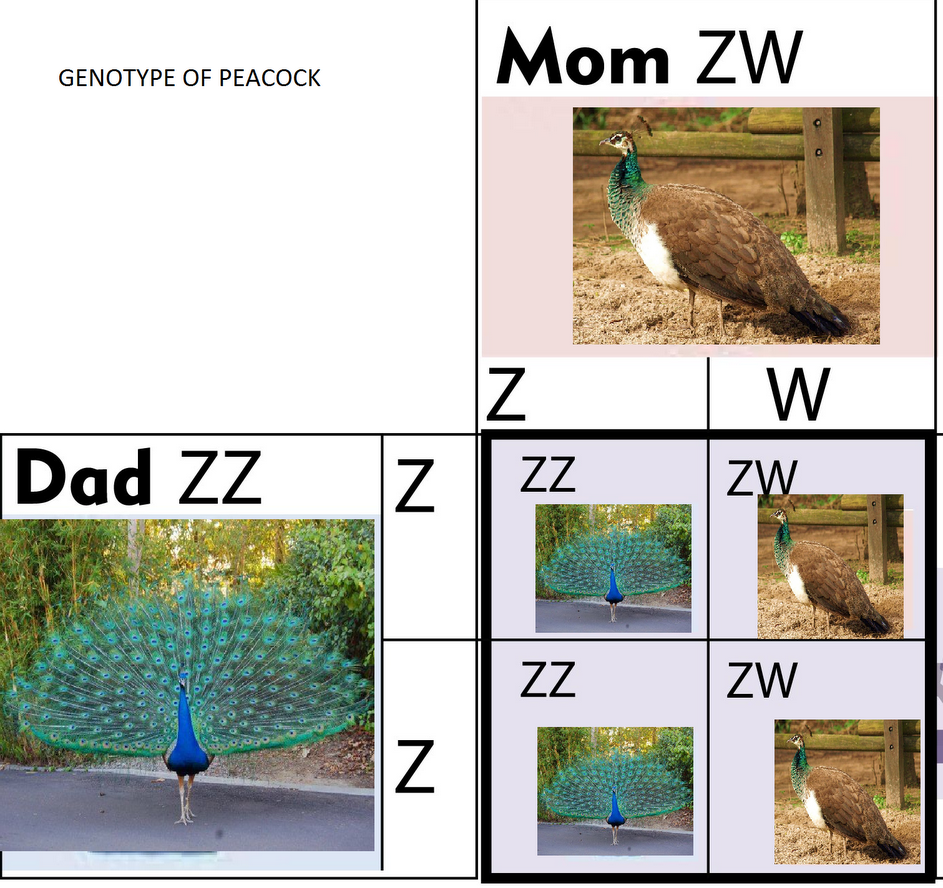
Peacock shows which of the following genotypes?
(A) XX
(B) XY
(C) ZZ
(D) ZW
Answer
554.4k+ views
Hint: Birds usually shows the ZZ-ZW system of sex determination, in which ZZ is shown by the males and ZW by the females. Peacock and Peahen ate the male and female versions of the peafowl.
Complete answer:
A peacock is a male peafowl and a Peahen is a female peafowl. In the ZZ-ZW system of sex determination, ZZ chromosomes will be seen in males while ZW chromosomes will be seen in females. This means that a peacock shows the ZZ genotype whereas a peahen shows the ZW genotype.
Additional Information: In contrast to the XY sex-determination system and therefore the X0 sex-determination system, where the sperm determines the sex, within the ZW system, the ovum determines the sex of the offspring. Males here are the homogametic sex (ZZ), while females are the heterogametic sex (ZW).The Z chromosome is always larger and has more number of genes in it, just like the X chromosome within the XY system.

Not a single genes will be shared between the avian ZW and XY chromosomes of the mammals and, from a comparison between chicken and human, the Z chromosome appeared almost like the autosomal chromosome 9 in humans, instead of X or Y, leading researchers to believe that the ZW and XY sex-determination systems don't share an origin, but these sex chromosomes are found to be derived from autosomal chromosomes of the common ancestor. It was thaught that these autosomes possess evolved sex-determining loci that eventually developed into the respective sex chromosomes once the recombination between the chromosomes (X and Y or Z and W) was suppressed.
So, the correct answer is ‘(C) ZZ’.
Note: In Lepidoptera (moths and butterflies), examples of Z0, ZZW, and ZZWW females are often found. This means that the W chromosome is important in the female determination in some species (ZZW), but not in others (Z0).
Complete answer:
A peacock is a male peafowl and a Peahen is a female peafowl. In the ZZ-ZW system of sex determination, ZZ chromosomes will be seen in males while ZW chromosomes will be seen in females. This means that a peacock shows the ZZ genotype whereas a peahen shows the ZW genotype.
Additional Information: In contrast to the XY sex-determination system and therefore the X0 sex-determination system, where the sperm determines the sex, within the ZW system, the ovum determines the sex of the offspring. Males here are the homogametic sex (ZZ), while females are the heterogametic sex (ZW).The Z chromosome is always larger and has more number of genes in it, just like the X chromosome within the XY system.

Not a single genes will be shared between the avian ZW and XY chromosomes of the mammals and, from a comparison between chicken and human, the Z chromosome appeared almost like the autosomal chromosome 9 in humans, instead of X or Y, leading researchers to believe that the ZW and XY sex-determination systems don't share an origin, but these sex chromosomes are found to be derived from autosomal chromosomes of the common ancestor. It was thaught that these autosomes possess evolved sex-determining loci that eventually developed into the respective sex chromosomes once the recombination between the chromosomes (X and Y or Z and W) was suppressed.
So, the correct answer is ‘(C) ZZ’.
Note: In Lepidoptera (moths and butterflies), examples of Z0, ZZW, and ZZWW females are often found. This means that the W chromosome is important in the female determination in some species (ZZW), but not in others (Z0).
Recently Updated Pages
A man running at a speed 5 ms is viewed in the side class 12 physics CBSE

State and explain Hardy Weinbergs Principle class 12 biology CBSE

Which of the following statements is wrong a Amnion class 12 biology CBSE

Two Planoconcave lenses 1 and 2 of glass of refractive class 12 physics CBSE

The compound 2 methyl 2 butene on reaction with NaIO4 class 12 chemistry CBSE

Bacterial cell wall is made up of A Cellulose B Hemicellulose class 12 biology CBSE

Trending doubts
What are the major means of transport Explain each class 12 social science CBSE

Which are the Top 10 Largest Countries of the World?

Draw a labelled sketch of the human eye class 12 physics CBSE

Explain sex determination in humans with line diag class 12 biology CBSE

Give 10 examples of unisexual and bisexual flowers

State the principle of an ac generator and explain class 12 physics CBSE




